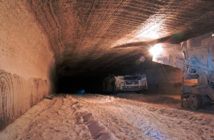San Francisco Chronicle
SF Gate

Christina Ammon
The Guerrouane region near Meknes has prime land for growing grapes in Morocco. Free from the appellations system that control vineyard plantings in France, French winegrowers enjoy the freedom to experiment in Morocco. They opt for heat-tolerant varieties, such as syrah and tempranillo. Photo: Andy Pag, Special To The Chronicle / SF
After three sober months in Morocco, my liver was healthy – but my teeth were in trouble.
The country’s beverage of choice – a gunpowder tea jammed with mint – comes sans alcohol, but is spiked with a minimum of six sugar cubes. No sooner had I made peace with this Berber whiskey (as the locals call it), than a longtime expat told me about a winery just a 40-minute drive or train ride from my base in the Fez Medina. I was dubious.
“They make wine,” he assured me. “Good wine.”
If the grape moonshine usually associated with Morocco’s back alleys hasn’t earned column inches in Wine Spectator, it’s understandable: Sommeliers don’t exactly flourish in Islamic countries, where alcohol is ummul-khabaith – the root of all evil. But in the past 15 years, two progressive kings have invited French winemakers to lease prime land, and a wine industry has begun to flourish.
Quietly.
Wine tours are not touted like camel trips in the Sahara or Berber village treks. Though the wineries are within easy reach of the major cities such as Marrakech, Casablanca and Fez, an informal ban on advertising means that tour operators must peddle wine trips discreetly.
Not advertised
“If we openly advertised the tours within Morocco, our business would be seen to be as disrespectful,” said Michele Reeves, who runs a tour company called Plan-It Fez. Guides often pair visits to the wineries with other adventures, such as tours of the historic city of Moulay Idriss or the Roman ruins of Volubilis, a UNESCO World Heritage Site.
“We try to remain low-key about wine,” Reeves said. “But in reality we are excited to be a part of this burgeoning industry that offers an interesting insight into the contradictions that take place in the country.”
Like so many of Morocco’s splendors, the country’s wine industry is dressed in plain clothes. You’ve got to know where to look.
We drove the poppy-lined highway toward Domaine de la Zouina, passing smoky truck stop tagine joints and teenagers selling honey out of flatbed trucks. As we skirted past the walled city of Meknes, the Middle Atlas Mountains were a purple haze on the horizon.
The winery was screened by a row of mature olive trees and searching for it felt like a covert operation. We drove passed the unmarked gate twice before finally calling the owner, Christophe Gribelin, for directions. Given the country’s attitude toward alcohol, winegrowers are wise be discreet.
But the lack of signage isn’t just discretion: The Frenchman simply wasn’t quite ready for visitors.
Gribelin still needs to hire staff, and plans for a restaurant are on the books. He might not be ready, but the tourists are. Without any advertising – or even a sign – the winery already had three group bookings for the weekend. Though Gribelin accepts groups, it will be about a year before he can easily handle drop-in visitors.
A guard opened the iron gate that marks the Domaine, and we drove a gravel road past red-soiled vineyards. It felt as if we’d left Morocco, and entered another country. As we stepped out of the car, a well-tended puppy clamored at our feet – a rarity in a country that hasn’t bought into the whole “man’s best friend” thing – and the winery building looked more chateau than minaret.
Gribelin greeted us with a formal demeanor, and we walked the vineyard. At 8,000 acres, his isn’t the biggest operation in Morocco – the nearby Celliers de Meknes holds that distinction – but is a key asset in establishing Morocco’s emerging reputation for quality wines.
It was early season, and the vines were just budding. Some varieties were familiar, like Cabernet Sauvignon, Tempranillo and Chardonnay. But some were novel – a late-ripening white called Vermentino and a deep red Mourvèdre. Back in France, a strict appellation system governs which grapes can be grown, and where. In Morocco, winegrowers are free to experiment.
Gribelin planted the heat-tolerant varieties in the limestone-clay soil 10 years ago. He’s tended them carefully, making special adaptations to cope with the climate. Hot winds from the Sahara, for example, known as the chergui require strategic foliage management in the vineyard to protect the grapes from sunburn.
On our way to the tasting room, we passed a vineyard worker named Mohammed Abba, who was training vines along a wire trellis. I asked Abba how he reconciled the alcohol prohibitions of the Quran with his job in a vineyard.
Abba made a distinction between working in the vineyard and working inside “la cave,” or winery. So long as he didn’t drink – or deal directly with the wine – he felt it was allowable, and he was grateful for a good job. Gribelin provides social security benefits, support for his children and a sheep to sacrifice on the Muslim holiday of Eid al-Adha.
The first sip
Inside the winery, Gribelin uncorked a bottle of wine. My heart leaped. For months, I’d been dreaming of how a good wine might pair with Morocco’s hearty lamb tagines and fluffy couscous. In fact, wine’s underground status had only increased its allure.
He poured a glass. The wine, Volubilis gris, is named after the nearby Roman ruins. It was pinkish and sweet but not syrupy, and it paired perfectly with the Moroccan heat.
“Ten years ago, they drank pretty bad wine, but now there is good production and they are able to choose good quality,” Gribelin said. Still, the old reputation is hard to shake in nearby Europe. Morocco is directing itsexports to fresher markets such as the United States or China.
Gribelin moved on to the next bottle, a Chardonnay, and from there we sipped our way through an entire flight, concluding with a jammy blend of Syrah, Tempranillo and Cabernet.
Despite its novelty, this isn’t the first French-inspired wine renaissance in Morocco. An industry flourished while Morocco was a French protectorate, and, by 1956, there were 135,905 acres in cultivation. The vineyards went fallow after independence, but the support of the past two kings has brought them back.
Still, this new wave of winemakers is small in the grand scheme of things.
Morocco’s production of nearly 10.5 million gallons hardly compares with California, which produces 607 million. Wine – and alcohol in general – is still regulated in this secular Islamic country. Bans on alcohol are frequently discussed. And while tourist resorts and some grocery stores sell alcohol, even these outlets seem marginal. After this year’s Eid festival, a few of them didn’t restock their alcohol sections.
If one needed justification for drinking wine in Morocco, they might invoke the “when in Rome” axiom. While the Meknes region might not exactly be Rome, it once was – 2,000 years ago.
Just 45 minutes from Gribelin’s vineyard is the winery’s namesake: Volubilis, once the southernmost city of the Roman Empire. Despite earthquake damage and subsequent pillaging, the site remains among the best-preserved Roman ruins in Northern Africa.
Along with the usual Corinthian columns, triumphal arch and olive presses, there is plenty of evidence of wine, women and song. The old brothel district (with its sizable stone phallus), attracts a photo-snapping crowd. An area called the vomitorium suggests a lot of overeating. Most remarkable are the well-preserved mosaics. Many depict hedonistic themes: The gods of wine, Dionysius and Bacchus, are everywhere, suggesting the ancient inhabitants liked their grape.
Export figures suggest that modern Moroccans like it, as well. Of the 30 million bottles produced by Celliers de Meknes, only 5 million of them are exported. This reflects a larger pattern of wine consumption. Gribelin guesses that as much as 95 percent of the country’s wine stays in the country – a statistic that implies one bottle per person. That’s per year.
As with so many things Moroccan, discretion reigns. And when it doesn’t, there is trouble.
At the Wine Festival held in Meknes in 2007. The event was well attended but held on a Friday, a Muslim holy day. Controversy erupted, and there hasn’t been a Wine Festival since.
“It was not done correctly,” Gribelin lamented. “It’s a shame because people loved it, and it was a good show for the city.”
Discretion and dignity
By the end of my Moroccan adventure, I began to conclude that while it might be haram – or sinful – to drink wine in Morocco, the worst offense might be to show it. In general, Moroccans favor discretion and dignity: They hide the wealth of their riads, or homes, behind plain medina facades. The women who meticulously primp and exfoliate at thehammams – or spas – are quick to cover their bodies under baggy djellabas.
As we left Gribelin’s vineyard, I was convinced of a bourgeoning wine scene in Morocco, but overwhelmed with mixed messages. Muslim women worked in his wine-labeling room, but wore headscarves and paused each day at the call to prayer. Gribelin couldn’t advertise his winery – yet a group of 20 French wine tourists were set to arrive the next day. Some restaurants and grocery stores peddled wine, yet taxi drivers were known to refuse rides to clients if they heard bottles clink in their bag. When it comes to describing Morocco’s relationship with wine, one can honestly say, “It’s complicated.”
For now, though, that complexity works in Gribelin’s favor.
“For everybody it is a Muslim country,” he says. “They are always astonished that we make good wine.”
If you go
There are several wine-growing regions in Morocco, including areas near Agadir, Casablanca, Marrakech, Rabat, Tangier and Tetouan. The Meknes area outside of Fez offers a compelling combination of historical landmarks, beautiful landscape and wineries. The town of Meknes is the usual base camp for visits to the area, but Moulay Idriss – Morocco’s holiest town – is far more scenic and nicely located.
Where to Stay
Dar Zerhoune: Comfortable rooms and a spectacular rooftop terrace. $20-$60 per night. 42 Derb Zouak, Moulay Idriss. 212-0-642-247-793. www.buttonsinn.com.
Where to Eat
Scorpion House (Dar Akrab): Good for a range of Moroccan wines paired with traditional food, atop one of Moulay Idriss’ distinctive hilltops. Enjoy views of the Volubilis ruins from the sun-flooded veranda. 54 Drouj El Hafa, Moulay Idriss, 212-0-655-210-172. www.scorpionhouse.com.
Wineries
Visits to the wineries are by appointment only and best arranged through a company. Plan-It Fez offers tours of the Meknes area wineries and attractions. 212-0-535-638-708.www.plan-it-fez.com.
Celliers de Meknes: Accepts direct inquiries. Appointments to tour the winery must be made two weeks in advance. 212-0-535-520-360. www.lescelliersdemeknes.net.
More information
Moroccan National Tourist Office: www.visitmorocco.com The site makes references to wine tasting but doesn’t elaborate. Use the “Contact” page to ask for specific information.
Christina Ammon is a freelance writer. E-mail: travel@sfchronicle.com
1 |2 |3Next »
Read more: http://www.sfgate.com/travel/article/Morocco-wine-forbidden-fruit-3884203.php#ixzz27E0Xk9Bl
.






